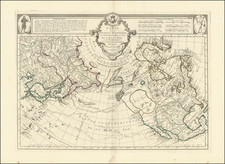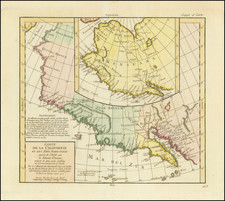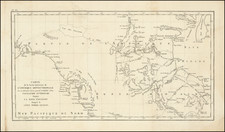Rare promotional map and brochure for the Yellowstone Park Line of the Northern Pacific Railroad.
Prepared in a rich topographically detailed style capturing the feel of the area's rugged terrain, the map shows the mines of the Osoyoos Division, Slocan Division, Nelson Division, Brunswick Division, Goat River Division and Trail Division in fine details.
The map promotes the route "To Spokane-Kootenai Mining Country", which at the time was in the midst of a major mining boom. The lines of the several railroads, including the S.F & N and Red Mountain Railway are shown, along with bright red notes showing gold, silver, copper and placers. The major road through the region is also noted.
Two inset maps show the region to the south (Oregon, Washington & Idaho), with details on railroad lines, and a smaller regional map with an overview of the entire Northern Pacific Railway.
The verso includes a text rich overview of the Kootenai and other mining regions, with a Time, Rate and Distance Table and numerous mining and related photos of the region.
Kootenay Gold, Silver & Copper
The first gold strike in the Kootenay region occurred in 1863, at the confluence of the Wild Horse and Kootenay Rivers in the East Kootenay region, which resulted in the Wild Horse Gold Rush and the founding of the region's first gold rush town, Fisherville, B.C. When it was discovered that the original town site was on a rich deposit, it was moved and the new town's site was officially named Kootenai (though still known as Fisherville). Galbraith's Ferry was established across the Kootenay near Fort Steele to facilitate crossing by the incoming rush of prospectors and merchants. Most of the gold was mined out by 1864.
In the early 1880s, the discovery of vast silver and lead deposits in the Coeur d'Alene district, notably around areas such as Burke and Kellogg, laid the foundation for a new mining boom. Names like Noah Kellogg, who is often credited with discovering the Bunker Hill mine in 1885, became synonymous with the mining folklore of the region.
The subsequent years saw the emergence of major mining operations. The Bunker Hill and Sullivan mines, established in the latter half of the 1880s, were among the most prominent and productive. By the turn of the century, these mines, along with others in the district, produced vast quantities of lead and silver, accounting for a significant portion of the nation's output.
The Northern Pacific Railroad, reaching Spokane in 1881, played a pivotal role in connecting the Kootenai mining region to external markets. Towns like Wallace and Mullan in the Coeur d'Alene district became significant mining hubs, with their fortunes inextricably linked to the ebbs and flows of the mining industry.
Other gold rushes on the Moyie and Goat Rivers, tributaries of the Kootenay, were followed by the discovery of silver and galena mines in the Kootenay Lake and Slocan Valley areas (Silvery Slocan), leading rapidly to the settlement of the region and the creation of various "silver city" boomtowns, notably Nelson, at the outlet of Kootenay Lake, Kaslo, midway up its north arm, New Denver, Silverton, Slocan City and Sandon in the 1880s and 1890s. By 1889, a smelter had been constructed close to the mouth of the Kootenay, near Revelstoke, to process ore from the mines. Serving the mines and settlers, steamer companies plied the Kootenai River from Bonner's Ferry, Idaho to Nelson and to the Lardeau or "Lardo" district at the north end of Kootenay Lake, and also on the upper Kootenay River between the Cranbrook-Fort Steele area and points in Montana.
Rossland, at the southeast part of the map was first discovered in July 1887 by two prospectors, George Leyson and George Bowerman, who were exploring in the area of Deer Park Mountain, after coming over from the nearby Dewdney Trail. After working all summer and taking several tons of ore from an 18 foot shaft, they concluded that the mine was not productive and abandoned it. In 1889, Oliver Bordeau and Newlin Hoover relocated the claim and named it the Lily May. The two men hired Joe Moris to help with the assessment work necessary to validate the claim under provincial mining law. Moris next joined Joe Bourgeois in prospecting the Red Mountain area, where they laid down five claims on July 2, 1890.
Moris and Borgeois went to Nelson to have the claims assayed. After relatively disappointing results, they asked the E.S. Topping, the Deputy Recorder in Nelson, if he would put up the money to register 4 of the 5 claims ($12.50), in exchange for ownership of the 5th Claim, which would become the Le Roi mine, the first of Rossland's famous mines.
In November 1890, Topping travelled to Spokane, where he met with Oliver Durant, who had made a name in the Coeur D'Alene mines. They reached agreement to do some exploratory work and if successful the mine would be valued at $30,000, with 51% sold to Durrant and his investment syndicate. At the same time, Moris and Bourgeois had located American investors for the War Eagle and Centre Star mines. Because the 3 major mines were controlled by American investors, a route to Spokane was created. In 1892, the Spokane Railway was extended to Northport, Washington, and a road was built to Rossland. A second wagon road was built in 1893 connecting Rossland with Trail Landing on the Columbia River.
Following the financial panic of 1893, work on the mines began again in earnest in 1894. With renewed interest, Patsy Clark, who worked the War Eagle mine, signed a contract in December 1894 with the East Helena Montana Smelting Company to supply at least 1,000 tons of ore per month. As word of this massive contract got out, the rush to Rossland began. In the next 3 years, two local smelters were constructed and two additional railroad connections were built.
In 1898 the Le Roi mine was sold to the British American Corporation for just over three million dollars. Once the mine came into production, Le Roi stock jumped from fifty cents a share to $40 almost overnight. The population of Rossland exploded as gold fever attracted men from around the world, and Rossland became one of the largest cities in Western Canada and a major business center in North America.
Many of the Rossland mines such as the Center Star, Le Roi, War Eagle, Josie, etc., became world famous. These mines were worked over the next forty years, creating the town of Rossland. By 1897, the population had increased to 7,000, with 42 saloons, 4 banks and 17 law firms. A smelter was built in the valley below, giving birth to the city of Trail. The mines and smelter were amalgamated in 1906 to form the company now known as Cominco.
Rarity
The map is extremely rare on the market. We note examples at the University of Alberta and Toronto Public Library.











![[Collection of 10 manuscript charts and maps depicting the west coast of North America from Monterey, California, to just north of Salisbury Sound, Alaska.]](https://storage.googleapis.com/raremaps/img/small/98898.jpg)

![Map of Oregon Territory. By Samuel Parker. 1838. [with:] Journal of an Exploring Tour Beyond the Rocky Mountains, under the direction of the A. B. C. F. M. 1840.](https://storage.googleapis.com/raremaps/img/small/97939.jpg)

![[ Alaska & Yukon ] Karte zur Abhanđlung über die Geogn. U. Orogr. Beschaffenheit der N.W-Küste Amerikas u. der anliegenden Inseln mit Zugrundelegung der Karten des Hydrogr. Dep. des See-Ministeriums zu St. Petersburg von C. Grewingk 1849](https://storage.googleapis.com/raremaps/img/small/101812.jpg)
